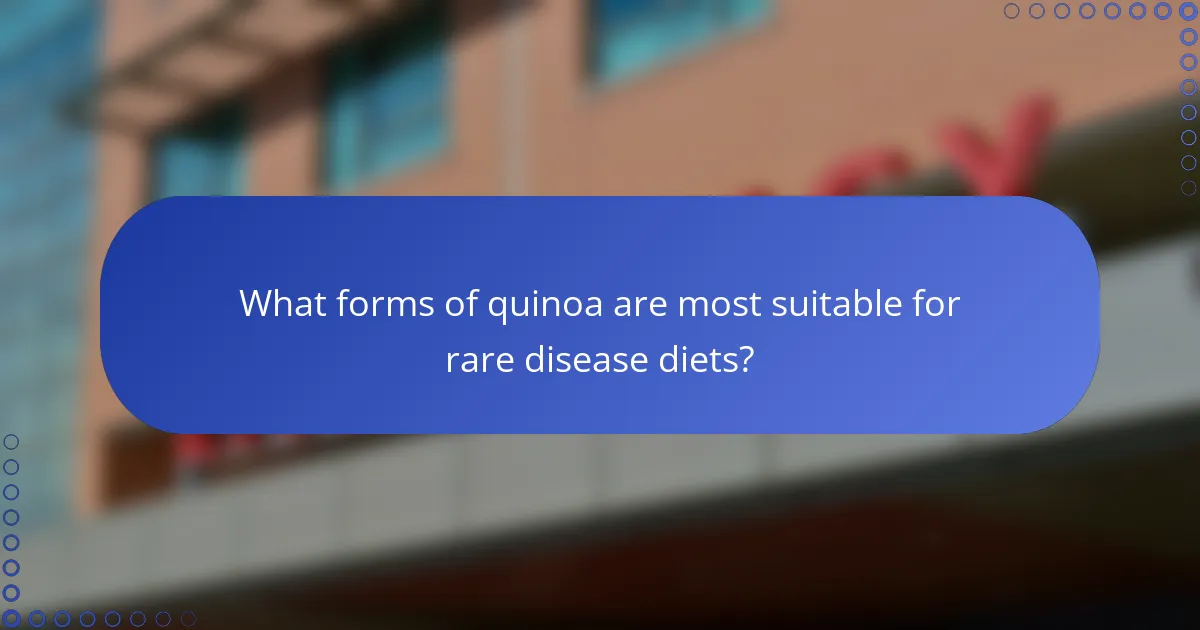Quinoa is a complete protein source that provides all nine essential amino acids, making it beneficial for individuals with rare diseases. This article explores quinoa’s nutritional benefits, its various forms for dietary flexibility, challenges in incorporating it into specialized diets, and strategies for optimizing its use. Additionally, we will discuss its gluten-free nature and how it supports digestive health for those with dietary restrictions.

How does quinoa serve as a complete protein source for dietary needs?
Quinoa serves as a complete protein source for rare disease diets by providing all nine essential amino acids. This unique attribute makes it especially beneficial for individuals with dietary restrictions. Quinoa contains approximately 8 grams of protein per cup when cooked, which supports muscle repair and overall health. Additionally, its high fiber content aids digestion, making it a suitable choice for sensitive digestive systems often found in rare disease patients.
What essential amino acids are found in quinoa?
Quinoa contains all nine essential amino acids, making it a complete protein source. This quality is particularly beneficial for individuals on rare disease diets, as it supports muscle repair and overall health. Notably, quinoa’s unique amino acid profile includes lysine, which is often limited in other grains. Additionally, it provides a rare combination of high protein content and fiber, promoting digestive health.
Why is quinoa considered a superior protein compared to other grains?
Quinoa is considered a superior protein due to its complete amino acid profile, making it ideal for rare disease diets. Unlike most grains, quinoa contains all nine essential amino acids, which are crucial for maintaining health, especially in individuals with specific dietary restrictions. Its high protein content, approximately 8 grams per cup when cooked, supports muscle repair and overall nutrition. Additionally, quinoa is gluten-free, making it suitable for those with gluten sensitivities or celiac disease. The unique attribute of quinoa is its ability to provide a plant-based complete protein, which is rare among grains.

What are the benefits of quinoa for individuals with rare diseases?
Quinoa offers significant benefits for individuals with rare diseases by providing a complete protein source essential for their dietary needs. It contains all nine essential amino acids, making it a valuable addition to restricted diets.
Additionally, quinoa is rich in fiber, which aids digestion and can help manage gastrointestinal issues often associated with rare conditions. It also provides vital nutrients such as magnesium, iron, and antioxidants, supporting overall health and reducing inflammation.
The unique attribute of quinoa is its gluten-free nature, making it suitable for individuals with gluten sensitivities or related disorders. As a result, quinoa can help diversify meal options and enhance nutritional intake for those with specific dietary restrictions.
In summary, quinoa’s complete protein profile, nutrient density, and gluten-free status make it an excellent choice for individuals managing rare diseases.
How can quinoa help manage specific nutritional deficiencies?
Quinoa can effectively manage specific nutritional deficiencies due to its status as a complete protein source. It contains all nine essential amino acids, making it particularly beneficial for individuals with rare diseases that require stringent dietary management. This quality supports muscle repair and overall health, addressing deficiencies in protein intake. Additionally, quinoa is rich in vitamins and minerals, such as magnesium and iron, which are crucial for metabolic functions and energy production. Including quinoa in the diet can help mitigate risks associated with nutritional gaps in these populations.
Which rare diseases may benefit from quinoa inclusion in diets?
Quinoa may benefit individuals with rare diseases such as phenylketonuria (PKU), cystic fibrosis, and certain metabolic disorders. Its complete protein profile provides essential amino acids that support overall health. Quinoa’s high fiber content aids digestion, which can be crucial for patients with gastrointestinal issues. Additionally, its rich micronutrient content, including magnesium and iron, supports metabolic functions that may be impaired in these conditions.

What forms of quinoa are most suitable for rare disease diets?
Quinoa is suitable for rare disease diets in its whole grain, flour, and puffed forms. Whole grain quinoa retains its nutritional profile, providing complete protein and essential amino acids. Quinoa flour is versatile for baking and can replace wheat flour in many recipes, making it beneficial for gluten-free diets. Puffed quinoa offers a crunchy texture, ideal for snacks or as a topping, while maintaining its protein content. Each form supports dietary flexibility for individuals with rare diseases, ensuring they receive necessary nutrients.
How do different cooking methods affect quinoa’s nutritional profile?
Different cooking methods can significantly alter quinoa’s nutritional profile. Steaming preserves more nutrients compared to boiling, which can lead to nutrient loss in the cooking water. Roasting quinoa enhances its flavor but may reduce some water-soluble vitamins. Cooking quinoa in broth can add flavor and additional minerals, enhancing its overall nutritional value. Ultimately, the method chosen impacts the retention of quinoa’s complete protein benefits, making it essential for rare disease diets.
What are the best ways to incorporate quinoa into meals?
Quinoa can be incorporated into meals in various ways, making it a versatile complete protein source for rare disease diets. Consider these methods:
1. Add cooked quinoa to salads for a protein boost.
2. Use quinoa as a base for grain bowls, topped with vegetables and proteins.
3. Substitute quinoa for rice in stir-fries or pilafs.
4. Include quinoa in soups for added texture and nutrition.
5. Bake quinoa into muffins or energy bars for a healthy snack.

What unique attributes of quinoa make it beneficial for rare disease diets?
Quinoa’s unique attributes, such as its complete protein profile and high nutrient density, make it beneficial for rare disease diets. Quinoa contains all nine essential amino acids, which is rare among plant foods, supporting muscle repair and overall health. Additionally, it is rich in antioxidants and anti-inflammatory compounds, aiding in the management of various conditions. Its gluten-free nature and versatility in cooking further enhance its suitability for specialized diets.
How does quinoa’s gluten-free nature support dietary restrictions?
Quinoa’s gluten-free nature makes it an ideal choice for individuals with celiac disease or gluten sensitivity. This grain-like seed offers a complete protein source, containing all nine essential amino acids, which is crucial for those with rare dietary restrictions. Additionally, quinoa is rich in fiber and various vitamins, supporting overall health while adhering to strict dietary needs. Its versatility allows for easy incorporation into various meals, ensuring that those with dietary restrictions can enjoy a nutritious and satisfying diet.
What is the significance of quinoa’s high fiber content for digestive health?
Quinoa’s high fiber content significantly enhances digestive health by promoting regularity and preventing constipation. Fiber aids in maintaining a healthy gut microbiome, which is crucial for individuals on rare disease diets. This dietary fiber helps manage digestive disorders and supports overall gastrointestinal function. Additionally, quinoa’s fiber content can contribute to satiety, helping regulate appetite and maintain a healthy weight.

What challenges exist when integrating quinoa into rare disease diets?
Integrating quinoa into rare disease diets presents challenges such as dietary restrictions, potential allergenicity, and nutrient absorption issues. Many rare diseases require precise nutrient management, making quinoa’s incorporation complex.
Quinoa, while a complete protein source, may not align with specific dietary needs. For example, individuals with phenylketonuria must avoid high-protein foods, including quinoa. Additionally, some patients may have allergies or intolerances that complicate quinoa’s use.
Nutrient absorption can also be a concern. Quinoa contains anti-nutrients like saponins, which may inhibit mineral absorption. This is particularly significant for individuals with rare diseases who need to maximize nutrient intake.
Lastly, the availability and cost of quinoa can be barriers. Rare disease diets often require specialized foods, and quinoa may not always be accessible or affordable, limiting its practical application.
How can individuals overcome potential allergies or sensitivities to quinoa?
Individuals can overcome allergies or sensitivities to quinoa by introducing it gradually into their diet and monitoring their reactions. Consulting a healthcare professional before making dietary changes is crucial.
For those with mild sensitivities, rinsing quinoa thoroughly before cooking can reduce saponins, which may cause digestive issues. Cooking quinoa properly can also enhance digestibility.
Incorporating quinoa in small amounts alongside other foods may help the body adjust. If reactions persist, consider alternative complete protein sources like lentils or chia seeds.
Always prioritize nutritional balance, especially for rare disease diets, ensuring adequate protein intake while managing sensitivities.
What are common misconceptions about quinoa’s nutritional value?
Many misconceptions exist about quinoa’s nutritional value, particularly regarding its status as a complete protein. Some believe quinoa lacks certain essential amino acids, but it actually contains all nine, making it suitable for rare disease diets. Additionally, some think quinoa is low in protein content; however, it provides approximately 8 grams of protein per cooked cup. Another misconception is that quinoa is solely a grain; in reality, it is a seed, which contributes to its unique nutritional profile. Misunderstandings about quinoa’s digestibility also persist, yet it is easily digestible for most individuals, promoting better nutrient absorption.

How can quinoa be optimized as a dietary staple for rare diseases?
Quinoa can be optimized as a dietary staple for rare diseases by leveraging its complete protein profile. It contains all nine essential amino acids, making it suitable for individuals with specific dietary restrictions.
Incorporating quinoa into meals can enhance nutrient intake, particularly for those with malabsorption issues. Its high fiber content supports digestive health, which is crucial for patients with rare diseases.
Quinoa is also gluten-free, making it a safe choice for individuals with celiac disease or gluten sensitivities. This unique attribute allows it to serve as a versatile base for various dishes, accommodating diverse dietary needs.
Finally, quinoa’s rich mineral content, including magnesium and iron, supports overall health, providing additional benefits for those managing rare conditions.
What expert tips can enhance the nutritional benefits of quinoa?
To enhance the nutritional benefits of quinoa, incorporate complementary foods, optimize cooking methods, and utilize proper seasoning. Pair quinoa with legumes to boost its protein profile. Cooking quinoa in vegetable broth adds flavor and nutrients. Adding herbs and spices enhances taste without extra calories.
Which common mistakes should be avoided when cooking quinoa?
To avoid common mistakes when cooking quinoa, rinse it thoroughly, use the correct water-to-quinoa ratio, and avoid overcooking. Rinsing removes saponins that can impart a bitter taste. The ideal water-to-quinoa ratio is typically 2:1. Overcooking can lead to a mushy texture, which diminishes quinoa’s unique properties as a complete protein source.